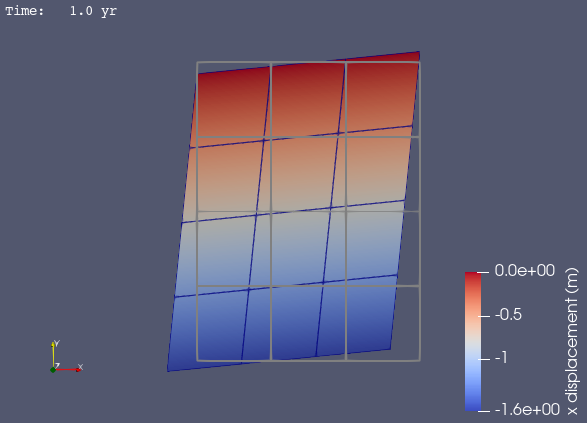Step 2: Shear Displacement#
This example corresponds to shear deformation due to Dirichlet (displacement) boundary conditions.
We apply Dirichlet (displacement) boundary conditions for the y displacement on the +x (boundary_xpos) and -x (boundary_xneg) boundaries and for the x displacement on the +y (boundary_ypos) and -y (boundary_yneg) boundaries.
Fig. 26 shows the boundary conditions on the domain.
Fig. 28 Boundary conditions for shear deformation. We constrain the y displacement on the +x and -x boundaries and the x displacement on the +y and -y boundaries.#
Features
Quadrilateral cells
pylith.meshio.MeshIOAscii
pylith.problems.TimeDependent
pylith.materials.Elasticity
pylith.materials.IsotropicLinearElasticity
spatialdata.spatialdb.UniformDB
pylith.meshio.DataWriterHDF5
Static simulation
ILU preconditioner
pylith.bc.DirichletTimeDependent
spatialdata.spatialdb.SimpleDB
Simulation parameters#
The parameters specific to this example are in step02_sheardisp.cfg.
These include:
pylithapp.metadataMetadata for this simulation. Even when the author and version are the same for all simulations in a directory, we prefer to keep that metadata in each simulation file as a reminder to keep it up-to-date for each simulation.pylithappParameters defining where to write the output.pylithapp.problem.solutionSpecify the basis order for the solution fields, in this case thedisplacementfield.pylithapp.problem.bcParameters for the boundary conditions. The displacement field varies along the boundary, so we use aSimpleDBspatial database and thelinearquery type.
$ pylith step02_sheardisp.cfg
# The output should look something like the following.
>> /software/unix/py39-venv/pylith-debug/lib/python3.9/site-packages/pylith/meshio/MeshIOObj.py:44:read
-- meshioascii(info)
-- Reading finite-element mesh
>> /src/cig/pylith/libsrc/pylith/meshio/MeshIO.cc:94:void pylith::meshio::MeshIO::read(topology::Mesh *)
-- meshioascii(info)
-- Component 'reader': Domain bounding box:
(-6000, 6000)
(-16000, -0)
# -- many lines omitted --
>> /software/unix/py39-venv/pylith-debug/lib/python3.9/site-packages/pylith/problems/TimeDependent.py:139:run
-- timedependent(info)
-- Solving problem.
0 TS dt 0.01 time 0.
0 SNES Function norm 2.239977678460e-03
Linear solve converged due to CONVERGED_ATOL iterations 1
1 SNES Function norm 1.964321818484e-18
Nonlinear solve converged due to CONVERGED_FNORM_ABS iterations 1
1 TS dt 0.01 time 0.01
>> /software/unix/py39-venv/pylith-debug/lib/python3.9/site-packages/pylith/problems/Problem.py:201:finalize
-- timedependent(info)
-- Finalizing problem.
The output written to the terminal is nearly identical to what we saw for Step 1. We omit the middle portion of the output which shows that the domain, the scales for nondimensionalization, and PETSc options all remain the same.
Visualizing the results#
In Fig. 29 we use ParaView to visualize the x displacement field using the viz/plot_dispwarp.py Python script.
First, we start ParaView from the examples/box-2d directory.
$ PATH_TO_PARAVIEW/paraview
# For macOS, it will be something like
$ /Applications/ParaView-5.10.1.app/Contents/MacOS/paraview
Next, we override the default name of the simulation file with the name of the current simulation.
>>> SIM = "step02_sheardisp"
Finally, we run the viz/plot_dispwarp.py Python script as described in ParaView Python Scripts.

Fig. 29 Solution for Step 2. The colors of the shaded surface indicate the magnitude of the x displacement, and the deformation is exaggerated by a factor of 1000. The undeformed configuration is show by the gray wireframe.#
